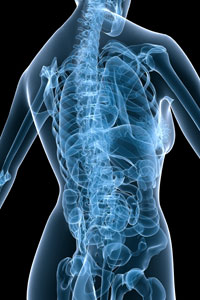![]()
Spinal Tumors
Facts | Symptoms | Causes | Diagnosis | Treatment options
Facts
Spinal
cord tumors are abnormal growths of tissue found inside the bony spinal column,
which is a primary component of the central nervous system (CNS). Benign tumors
are noncancerous, while malignant tumors are cancerous. Because the central
nervous system is found in rigid, bony quarters (i.e., the spinal column),
any abnormal growth, whether benign or malignant, can place pressure on sensitive
tissues and impair function. 
Symptoms
Symptoms of spinal cord tumors generally develop slowly and worsen over time unless they are treated. Spinal cord tumor symptoms include pain, sensory changes and motor problems.
Causes
Tumors that originate in the brain or spinal cord are called primary tumors. Most primary tumors are caused by out-of-control growth among cells that surround and support neurons. In a small number of individuals, primary tumors may result from specific genetic disease (e.g., neurofibromatosis, tuberous sclerosis) or from exposure to radiation or cancer-causing chemicals. The cause of most primary tumors remains a mystery. They are not contagious and, at this time, not preventable.
Diagnosis
The first test to diagnose brain and spinal column tumors is a neurological examination. Special imaging techniques, such as computed tomography, magnetic resonance imaging and positron emission tomography are also used. Laboratory tests may include the EEG and the spinal tap. A biopsy is a surgical procedure in which a sample of tissue is taken from a suspected tumor and may help doctors diagnose the type of tumor.
The tumor may be classified as benign or malignant and given a numbered score accordingly. This score can help doctors determine how to treat the tumor and predict the likely outcome for the patient.
[top]
Treatment
The three most commonly used treatments are surgery, radiation and chemotherapy. Doctors also may prescribe steroids to reduce swelling inside the CNS.
IMRT radiosurgery
The spinal cord can only tolerate certain amounts of radiation. Intensity-modulated radiation therapy (IMRT) can treat paraspinal tumors of any shape or size while at the same time sparing the greatest amount of normal tissue. This highly advanced technique involves using digital images of the tumor to coordinate a three-dimensional approach in which beams of radiation are delivered to the tumor. The radiation is controlled and therefore can better target the region where the tumor resides with a more concentrated dosage.
IMRT radiosurgery represents a significant advance within the field of spinal tumor treatment and is expected to eventually become the standard treatment for primary and metastatic tumors.
[top]







